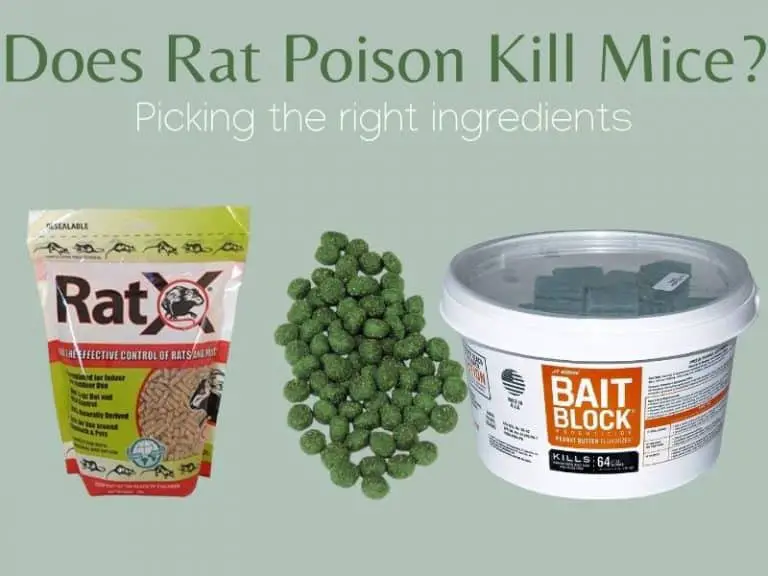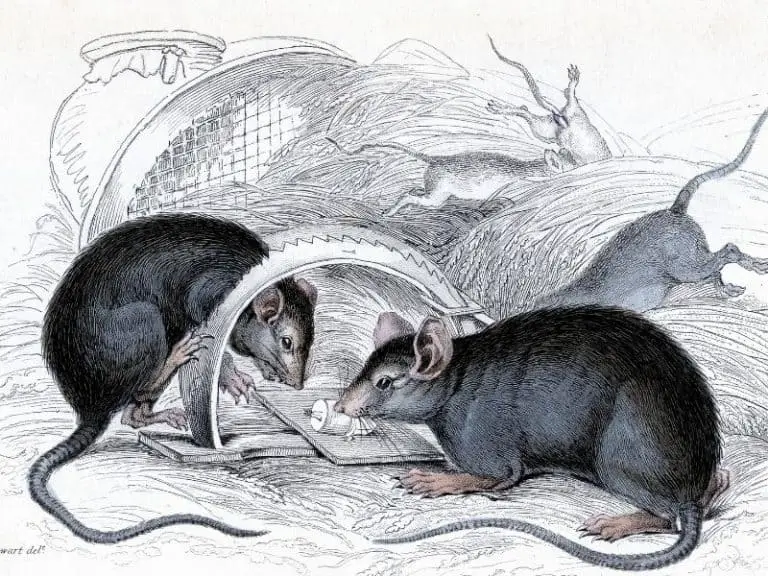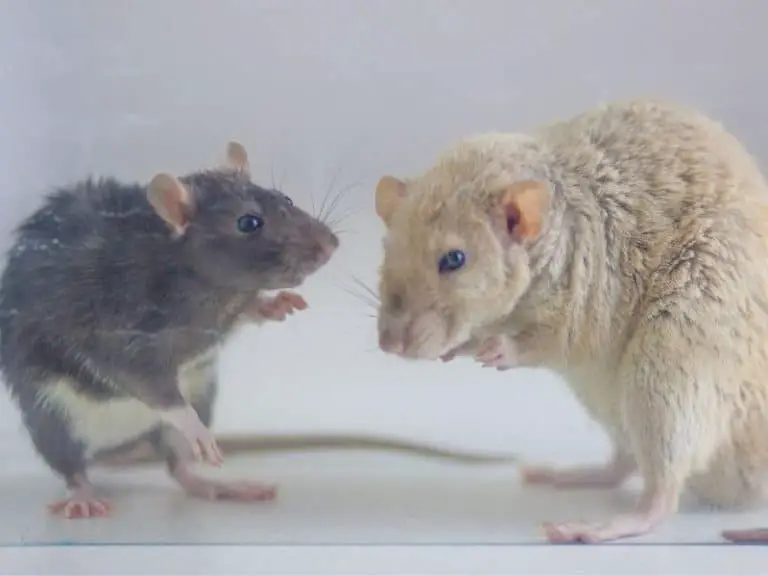How to Get Rid of Rats Without Harming Pets
If you have pets living with you at home, and you, unfortunately, have to deal with rats, this can be a problem. There are definite steps you can take to get rid of rats without harming your precious pets. What can you do to get rid of rats while making it easier for pets to survive and thrive?
Getting rid of rats without harming pets require a combination of strategies, such as using traditional and newer trapping technologies, bait stations that are pet-proof, or poisons that are not toxic to pets and children but toxic to rats.
This combination of strategies that it will take to get rid of rats without harming pets is the subject of this post.
Take a moment to read this post and learn how you can deal with your rat problem while keeping your precious pet safe. You may also find that this advice works when you have small children at home.
Ways to Getting Rid of Rats Without Harming Pets
This is a list of ways we can get rid of rats without harming pets.
These rely upon strategies that have been proven to work in rodent management, especially in situations where pets and children are involved.
We do not recommend doing each of these steps alone. Often, they are best done in conjunction with each other.
There are other, more interesting ways to deal with rodents without harming pets.
Some pest control experts suggest using smoke bombs to draw out rats from hiding and owls to catch mice and other rodents, especially in your yard.
Yet some professionals recommend traditional ways like using traps of various sorts. This is what we prefer to emphasize in this list.
One of the things we also want to emphasize is doing these steps safely.
The main reason we want to get rid of rats without putting pets in danger is to provide the latter with a safe environment to survive and thrive.
This is the most important thing to consider when taking steps like the ones we are suggesting.
Use Newer Trapping Technologies
One of the great things about our time is that there are more ways to catch (and kill) a rat than there used to be.
The introduction of traps that rely on electric power and CO2 gas to kill rats is a good thing. These traps prevent one problem that traditional traps have, which is that pets who aren’t careful enough will get caught in them.
Traps such as this electronic trap sold on Amazon are purposely built for rats, though it also works with mice. This trap uses a bait mechanism that triggers an electric shock that lasts long enough to kill the rat.

The trap can be placed to “set and forget.” The only sign that you have killed a rat is the flashing green light on top.
On the other hand, traps that use CO2 gas to poison rats work on a different principle, which is killing them with an excessive amount of carbon dioxide.
The gas is toxic in large quantities depending on one’s size and metabolism, and the trap is designed with that in mind. It is self-resetting, meaning that the trigger re-arms itself after use.
Both traps’ chief advantage is that it does not use any harmful poisons that will be bad for pets. However, their chief disadvantage is that they are somewhat more expensive than traditional trapping technologies.
What makes them appeal to us, though, is that they are a good investment for keeping pets safe.
Use Snap Traps
Either in place of or alongside newer trapping technologies are the ones with which we have become quite familiar.
Here, we speak about the most reliable snap trap.
The snap trap works on the principle that a trigger will activate a spring-operated metal rod that quickly snaps the neck of the rat, thus killing it.
Snap traps, when placed and baited properly (see below), are most effective in catching rats. The upside is that they do not make use of dangerous poisons that may affect pets; food bait will do.
The downside is that animals may be drawn to food bait used in traps and they may be harmed in the process.
There is one other kind of trap we will discuss later. We will briefly mention why glue traps, while sometimes helpful, are ineffective.
They are helpful in catching mice and smaller rats, whose bodies easily get stuck in the glue. There is the possibility that larger rats will manage to break free more easily from the glue.
Use Bait Stations

Bait stations are usually places where, as the name suggests, rats can stop by to eat bait that is attractive to them.
There are several types of stations, but the most popular ones usually sold on the market rely upon the bait being inside a plastic container with an access hole. The rat has to get to the bait by entering the station and nibbling on it.
The reason we would recommend these commercially available bait stations is that they are often marketed as pet-proof.
This means that the construction of the station is such that a pet cannot access the bait, which is often a toxic substance that is potentially harmful to them. The pet simply cannot claw their way into the box.
Bait stations are best placed in locations such as corners and other places where rats travel.
In conjunction with food bait, using bait stations and making rats familiar with them may solve a problem which bedevils people hunting for rats: the problem of rats’ neophobia or fear of the new. This requires careful strategizing.
Choose Rodent Bait Wisely
Rodent bait products come in all sorts, but the most common kind on the market are blocks and nuggets.
When people often think of rodent bait, they think of the kind of bait that will kill rats, either quickly or slowly. It is wise to remember at this point that no form of rodent bait will kill a rat instantly; it takes time.
When considering what kind of rodent bait could be used in locations where pets may go, the active ingredient is an important consideration.
One of the most recommended is using warfarin-based bait.
Warfarin is one of the earliest multiple-dose or first-generation anticoagulants, but warfarin resistance is a phenomenon worth considering. I wrote an article that discusses various rat poisons in great detail.
In any case, when you have chosen your bait, it is important that you place your bait in places where non-target animals, that is, pets, won’t visit.
Basements and attics are good places to leave such items, especially if these are pretty harmful to pets. As we will mention later, storing these bait blocks or other items safely is important.
Use Non-Toxic Poison Products
If you are concerned about the harm regular poisonous bait can do to your pets, consider using a rat poison that is harmless to pets.
Their active ingredients, surprisingly enough, are mostly harmless. This non-toxic poison product has two of them: cornmeal and salt. Sounds perfect for your pets, right?
This particular product relies upon a property of a rodent digestive system that is different from, say, a human’s. Rats and mice absorb water through their lower gut.
If the gut is lined by a particular substance such as that found in the product, the gut will fail to absorb water. Dehydration and eventual death will follow.
The non-toxicity of this item for pets is what we find attractive about this product. The disadvantage is that, unlike some other bait products with particular active ingredients, it takes more time for rats to die.
It normally takes 4-6 days for this product to work. However, the time it takes is definitely worth it to keep your pet safe.
If, however, you are keen about making homemade pet safe rat poisons, try these recipes out. They all work on principles similar to the non-toxic poison product we described above. They may be cheaper too!
Place Your Traps and Bait Properly
One of the worst things that can happen to someone wanting to get rid of rats is not being able to catch them at all. There are several reasons for this.
One reason is that rats will see the trap as something unfamiliar to avoid. Another reason is that a trap was placed and set somewhere that isn’t where rats are active.
This latter reason is why traps and bait should be laid out in places where there is significant rat activity.
When dealing with trails of droppings and grease marks, as we will see later, you could easily tell where rats have been going around. This helps you find out where to lay traps and place bait. This is not only to help you catch rats, though.
Placing traps and bait in the right places can sometimes mean placing them out of the reach of your pets.
Pets may be injured by certain kinds of traps, especially snap traps when they are triggered.
They might swallow bait that contains poisonous substances. Putting them where rats will go but where pets won’t is the best solution.
We will later explain why understanding rat behavior is key to laying down traps effectively and properly. When you are ready to do so with patience and persistence, you will find that your efforts will pay off in seeing your rat numbers under control.
Use Live Traps
Pets may be injured by snap traps or inconvenienced at least by glue traps. Also, you may have reservations about wanting to kill rats altogether because of ethical or other reasons.
Bringing these two interests together is easy: get yourself a live trap. These traps come in different sizes depending on the “target animal.”
Live traps basically work on the principle that a rat or other animal is drawn to bait on a trigger inside the cage.
The trigger, when pushed, drops a small door that will prevent the animal from leaving the cage or trap.
Different manufacturers have different ways of doing this, but this principle is what they have in common.
Using live traps in conjunction with food bait is something worth considering especially when you have pets at home.
You avoid the problem that eventually arises when dead rats attract the attention of your pet. The risk of catching the disease is already high when it comes to contact with rat droppings. It may be worse with a dead body.
Also, it is important to remember to remove and free the entrapped animal as soon as possible.
A wooded area at least half a mile from home, whenever possible, is a great spot to drop off rats caught in live traps. You may feel that it is better for them to survive and die naturally than at the claw of a snap trap.
Store Bait Stations and Rodenticides Properly
Whether you have pets or not, keeping poisons stored properly is a basic safety principle.
Bait and bait stations that use some form of rodenticide should definitely be kept away in situations where you have pets and children around the home.
Some rodenticides, like anticoagulants, have effects that work on other mammals.
The best place to store these items is in a locked cupboard or cabinet away from any areas meant for food storage and preparation, such as in the kitchen or dining area.
If possible, label the cabinet or cupboard with a reminder to keep the contents away from pets and children. Keep the key with you or another responsible adult if needed.
Storing bait stations and rodenticides properly is another measure in your quest to get rid of rats without harming your pets, because bait refills, if not stored properly, may spell the difference between a pet’s life or death, not just a rat’s.
And when you do handle the bait, do so with care, and make sure your pets aren’t around!
We now move on to a series of related topics that will help you with your rat control concerns.
These will help you learn about the threat rats pose to you and your pets, and other helpful topics that will make your quest to rid your house of rats much more effective.
How Can You Tell If It Is a Rat?
If you are sure that you are experiencing a rat infestation, you are on the right track.
However, we often confuse mice and rats in practice, but telling them apart is actually an easy thing to do. If you are lucky to see a live rodent in action, it may be easy to tell which one is which.
The general difference between rats and mice is that rats are usually larger than mice.
They weigh more, and are large and stocky (Norway rat) or longer and sleeker (roof rat). Mice, on the other hand, are smaller and lighter. What causes the confusion is when these rodents, at times, tend to resemble each other.
The thing to remember is, you cannot have mice and rats at the same time in your house.
Mice consider rats, like humans, their natural predators, and rats are not too particularly fond of mice. This definitely helps when telling them apart.
Another way of telling them apart is through their droppings; rats and mice have differently shaped ones.
Norway or Brown Rat

The Norway or brown rat, also known as the sewer rat, has a blunt snout and is quite large. They are reddish brown on their upper body and gray underneath.
Their tails are shorter than their bodies. They can be found throughout the continental United States. Adult Norway rats weigh between 7 to 18 pounds.
Though Norway rats are perfectly capable of living in the wild, it is when food starts running low in fall that they decide to pay a visit to a house where they can find food and shelter.
They are very agile creatures, fitting their bodies into holes as small as half an inch. Their preferred spots at home are basements and attics.
How can one tell if the rodent invading your house is a Norway or brown rat?
The droppings provide a tell-tale clue. They are capsule-shaped and are often left along trails where the rat regularly travels. Norway rats are omnivorous, meaning that they can eat anything from meat to fruit to grains.
Roof or Black Rat

The roof or black rat is distinguished by its sleek shape, its pointed snout, and its longer tail. It also has large eyes and ears. As its name indicates, it is distinguished by its black to brown hair.
It grows up to 5 to 7 inches long and its tail can grow up to 8 inches long. It can be found mainly in coastal or tropical regions, but adapts well to colder weather.
These rats are particularly agile and eager to get inside a structure to nest. They can travel on electrical wires and tree branches to get to roofs, and often enter structures through uncovered vents and holes.
Roof rats are omnivores too, and they particularly like seeds, fruit, stems, leaves, insects, and, yes, pet food.
Roof rat droppings are spindle shaped, meaning that they are pointy at both ends. Like the Norway rat, they leave grease trails around their paths.
They tend to hoard food, which may also attract other insects (which are part of their diet). Females tend to give birth to up to 40 offspring a year.
Both rat species can survive for up to a year in the wild, but much longer under the controlled conditions of a home.
What Harm Can Rats Do to Pets?
Your dog or cat (and we assume that is what you have) will definitely be harmed by rats.
In general, rats bring diseases into a home, and if your animal does not receive the properly updated shots, chances are they will get sick, infect others, or worse.
This often happens when rats confront cats and dogs. The former fights back when cornered.
Rat bites, for example, may transmit bacteria which, if a dog or cat comes into contact with it, causes a bacterial infection called rat bite fever.
The unlucky dog or cat may need to be treated for the infection and the illness it causes.
Some deadlier illnesses exist which infect cats and dogs and transmit them to humans. One of these illnesses is leptospirosis, which happens when pets come into contact with rat urine.
The infection affects their kidneys, which in turn affects their ability to absorb water into their system and subsequently die.
If you wish to prevent further harm to your pets, the solution is to be as aggressive as possible with your rat control measures, using the strategies we outlined above to minimize the harm to your pets.
Since rats spread disease that infects both pets and humans, it is all the more important that their numbers should be controlled.
Signs of Rat Behavior and Activity
There are several signs of rat behavior and activity around your home. The first is what they leave behind, namely droppings or tracks.
The second is the kind of noise they make in areas of heavy activity. The third is how your pets express unusual behavior.
Let’s go through these one by one.
First, rat droppings are a clear sign of rat activity. They can be capsule or spindle-shaped. They can be found along trails or near areas where rats are known to be nesting or staying.
The other sign in this regard is the grease marks rats tend to leave among walls. Since rats have poor eyesight, they rely on touch to feel their way around.
Secondly, rats can make several kinds of noises, especially at night. Scampering or scurrying noises indicate that they are moving around the house.
They can also make scratching, gnawing, or rustling sounds. They make hisses and squeaks, especially when they are in pain or are afraid.
Thirdly, a sign that there is rat activity can be found with your pets. Your pet, for instance, seems to be very curious around a wall or looking intently up at the ceiling for no discernible reason.
It is likely that they would be interested in unusual activity going on there. Another example would be dogs barking at areas they normally would not.
When you notice these signs of rat behavior, start working on getting rid of the rats. First, however, disinfect and get rid of the droppings—they are a health hazard!
How Do You Prevent Rats From Harming Your Home?
Since rats pose a threat to your home and especially to your pets, there are steps you can do to keep your home safe and rat-free.
After you have gotten rid of the rats without harming your pets, here are some of the things you can do to keep your home safe from further rat infestation.
The first is to plug any holes and cracks and cover any vents that need covering. We have seen that rats, whether brown or black, are agile enough to fit small holes.
Vents are particularly vulnerable places where rats can enter if they are not covered. Try cutting down tree branches which roof rats can use to cross over to your house.
The second is to clean up as much as possible. A dirty home is more attractive to rats, especially if food scraps are not immediately cleaned up or disposed of.
Clear the attic and basement periodically of items that may provide a good, safe nesting place for rats. Clear unnecessary vegetation around the house that may provide shade for rat burrows.
The third is to prevent rodents from making your home a place to get food and water. Repair any leaks in plumbing that may provide free water for rats and mice.
Store food items in rodent-proof plastic containers. Remove any food items in cardboard and paper bags from storage in places like the garage or other unprotected spaces.
There are more tips we can advise, but the principle is the same: depriving rats of food, shelter, and warmth is the best way that they don’t have to cause harm to us and our beloved pets again.
If you are concerned about how a rat infestation can be solved while being safe for pets, consult a pest control professional.
Photo credit: ©canva.com/sever180, ©canva.com/amnarj2006, ©canva.com/argument, ©canva.com/whiteway
Medical Disclaimer: TheHomePestControl is a digital publisher and does not offer personal health or medical advice. The contents of this website are not intended to substitute for professional medical advice, diagnosis, or treatment.
Affiliate Disclaimer: As an Amazon Associate, I earn from qualifying purchases made on our website. If you make a purchase through links from this website, I may earn a commission at no additional cost to you.






